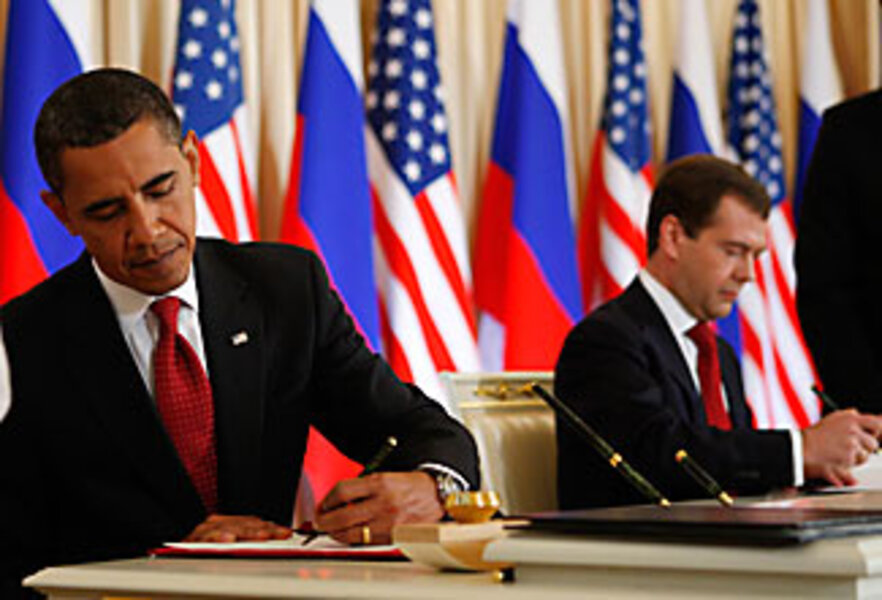US, Russia deal would cut nukes to post-cold-war lows
Loading...
| Washington
President Obama and Russian President Dmitry Medvedev committed Monday to reaching a new nuclear-arms reduction agreement that would set both strategic warheads and warhead delivery vehicles, such as missiles, at post-cold-war lows.
Yet despite the upbeat tone at the first of two days of summit talks in Moscow, the two leaders offered few specifics on how the looming stumbling blocks to a new era of cooperation will be overcome. Those issues include American plans for a missile-defense system in Eastern Europe and US-supported expansion of NATO to Ukraine and Georgia.
The two presidents issued a "joint understanding" that commits the two countries to reducing strategic warheads to a range of 1,500 to 1,675 – down from the current ceiling of 2,200 – and to a maximum of 1,600 launch vehicles. The goal is to reach an agreement in time to replace the Strategic Arms Reduction Treaty (START), which expires on Dec. 5.
Although the Obama-Medvedev statement speaks only of reaching an agreement "at the earliest possible date," Mr. Obama affirmed at a joint appearance of the two leaders Monday that the treaty "will be completed this year."
Arms-control analysts who support Obama's determination to conclude a new START agreement say that the stated reductions are significant because they are realistic enough to receive the legislative-branch ratification required in both countries, yet ambitious enough to act as a first step toward Obama's vision of a world eventually free of nuclear arsenals.
"They've hit the sweet spot in finding numbers that will be a significant reduction and likely to get the necessary support in their respective parliaments," says Joseph Cirincione, president of the Ploughshares Fund, a Washington foundation focused on nuclear-weapons reduction and nonproliferation.
The numbers announced Monday, Mr. Cirincione notes, amount to a 30 percent reduction in the nuclear arsenals of the two countries that possess 95 percent of the world's nuclear weapons.
"That makes this a serious down payment on the larger vision of heading towards zero," he says. "Both of these presidents have spoken of that goal, and this statement starts us down that road."
Critics of Obama's intentions for a follow-on START and his larger vision of a world with zero nuclear weapons fear the first goal will come at the cost of other US priorities like a missile-defense system. The second goal, they say, will only embolden states with lesser nuclear arsenals and those not yet possessing them.
John Bolton, a nuclear-proliferation expert from the Bush administration who is now at Washington's American Enterprise Institute, has said that by rushing to reach a replacement treaty by December, the Obama administration is ceding ground that the United States has never offered before – such as a "linkage" between nuclear-arms reduction and missile defense.
At Monday's press conference, Obama said his administration has agreed "to discuss defensive as well as offensive weapons systems" as part of the treaty negotiations. The issue of missile defense has been under strategic review by the Obama administration.
Obama added at the press conference Monday that the planned missile-defense system, which would include installations in Poland and the Czech Republic, is not aimed at Russian capabilities, "so in that sense it is not necessary to link" the two issues.
But Mr. Medvedev responded from a different perspective, saying, "Now that linkage [between offensive and defensive weapons systems] is being discussed," this is a step that "opens up opportunities to take the issue forward."





